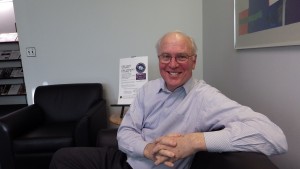The futurists in the gray-flannel suits

Building a tech community differs from building other communities. Once in place, the freeform tech community ”“ fueled by projects ”“ possesses the power organically to attract businesses that need to tap its talent for specific projects.
Such a tech community lacks the brick and mortar of communities past, but face time still matters and the talent must be in a certain physical place and not located solely on the Internet. What might appear a loose configuration of people who are all good with computers in fact requires what Business Council of Fairfield County President/CEO Chris Bruhl called, “a deliberate effort to make it happen.”
It is an equation playing out in Durham, N.C., Nashville, New Orleans, Boston and along the sawtooth stretch of Connecticut shoreline between Stamford and New Haven, the recently branded iCoast.
“Large companies help small companies,” Bruhl said. “The smaller companies lack recruiting power. The larger companies need a talent community that works in increments of 20-month gigs.”
Last fall at the Stamford Innovation Center, the Business Council of Fairfield County supported the Stamford-based Shippan Institute”™s efforts to rally the local tech community for a successful hackathon that across a weekend produced a detailed map of Stamford.
In 2016, there could perhaps be no better way to demonstrate a tech community is thriving locally than to show the entire world you’ve got game, specifically that the region possesses the talent to participate in the Jan. 29-31 Global Game Jam, run locally by the Business Council of Fairfield County and hosted by the Stamford Graduate Center of Sacred Heart University at its 1 Landmark Square campus in Stamford.
The game jam sponsor list offers a barometer of the importance of the issue. It includes CTNext, a program of Rocky Hill-based Connecticut Innovations, which partners with venture capitalists, lenders, government entities, private industry and universities to promote tech companies; plus the Business Council of Fairfield County’s Tech Talent initiative backed by The Ashforth Co.; Deloitte; First County Bank; Frontier Communications; KPMG LLP; PwC LLP; UIL Holding Corp.; and Wells Fargo Bank N.A.
The A100 apprenticeship program ”“ a successful New Haven program started by Independent Software that the business council brought to Stamford ”“ is another example of helping to craft a tech community.
The A100 program addresses a problem of the new economy. There are many with some coding experience, but who lack the skills to jump into a small or midsize shop and immediately produce. “Only the largest companies could afford to train them and that’s not realistic,” said Bruhl. He said the first A100 Stamford class had just graduated 20.
Bruhl said A100 is an early result of the iCoast idea. “A100 is based in New Haven and they came because in the iCoast vision, it’s the same place. It’s an example of bringing in a successful resource.”
Bruhl also said localizing the A100 effort began with a relationship, a council specialty. “What do you have for me?” he said. “What can we do for you? Someone has to be the orderly manager of those practices. That’s the business council.”
At the Young Professionals Network of Fairfield County, another business council initiative, there is a 5-minute survey designed to steer the council”™s 2016 events: when they should be held and what their thrust should be. Social media, naturally, is a survey-listed potential topic among more typical business arenas like medicine or food and beverage.
Bruhl cited several broad pushes that he termed the council”™s signature initiatives. They include:
- Infrastructure and resilience:Â Bruhl aligned this category with the business council”™s traditional concerns of energy and transportation, but noted new thinking must also factor climate change and rising seas.
- Human capital:Â “This is about how employers attract and maintain workers, but we also look at higher education as a system and on workforce development, which has its own, complete focus.” He and the business council also cite “health competitiveness” as a human capital component. Bruhl said 20 percent of the U.S. gross domestic product goes to health care and that health and wellness are integral to human capital.
- Innovation and entrepreneurship:Â “We de facto expanded this 3 years ago and last year formalized it,” Bruhl said. “We had turned from startups and early-stage companies and from companies that just didn”™t have the time to participate in our programs because they were busy making sales and opening the shop. We had inadvertently acquired less and less understanding of startups and smaller companies.”
Bruhl said the corporate executive network assembled by the business council can be hamstrung as far as adding local jobs, “But they want to help.” He said this quest for best practices from among executives ”“ a hallmark of the business council regardless of the effort ”“ has revealed, “Nobody gets it all right. But we can learn from business groups and from public-private partnerships guided by private-sector vision leaders,” he said.